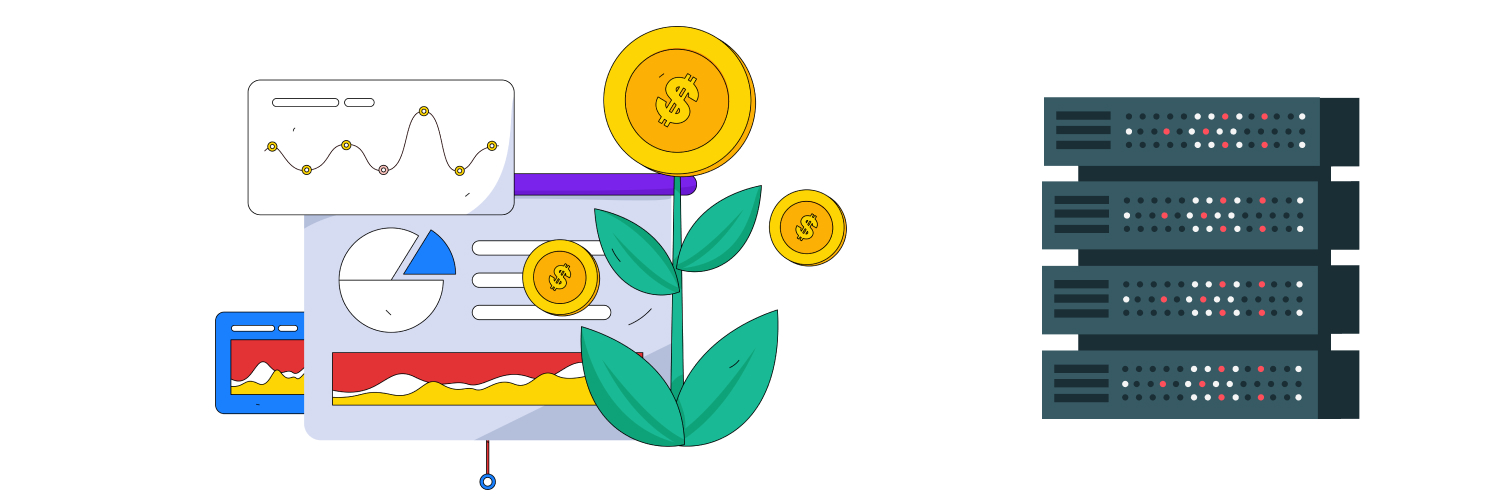How Big Data Is Changing HR (And How To Leverage HR Data)
The decisions of your company’s Human Resources (HR) department shape your business’s daily operations, ongoing progress, and future growth. With stakes that high, it is essential HR has at its disposal the most effective, up-to-date tools available to ensure the optimal fulfillment of the department’s responsibilities, all of which center around one single, powerful word: people.
As the business landscape advances and changes, so do the responsibilities of HR. Fortunately, technological advances have introduced many tools to streamline and improve existing HR processes. Technology has also provided entirely new ways to gather and leverage so-called Big Data for HR purposes. Regardless of how human resources professionals do it, it is essential to analyze your company’s HR data for many reasons.
The Role of Human Resources Revolves Around HR Data

The definition of “data” boils down to a very simple thing: collected information. We process data every day without even thinking about it. Data comes at us from every direction: conversations with other people, emails, text messages, social media, newspapers, the internet, TV, and multiple other sources. Some data is easily qualified and quantified; other data is not as easy to nail down, put on paper, or organize.
In essence, any company or organization’s HR department is responsible for managing each employee’s life cycle. This means HR deals with the people who work within a company from the recruitment phase through the end of the employment relationship and every stage in between. At every stage, data is collected and cataloged by HR. Some of the countless tasks handled daily by HR include:
- Recruiting job candidates: For HR to fill a job position, they must first understand the company’s needs. They must also research what skills, qualifications, and characteristics a candidate must have to be the right fit for that particular position. They need to study the current job market and the company’s budget, consult management and stakeholders and determine the organization’s requirements. They must craft job descriptions and employment ads and vet the candidates who respond to ensure the posted ad transmits the appropriate message about the position in question.
- Hiring employees: HR must set up and conduct job interviews, run background checks, contact candidates’ references, administer testing, and ensure the proper paperwork is completed for each new employee hired. Then, it is also generally the responsibility of HR to onboard and train each hire, set up payroll, and set up and administer the appropriate benefits.
- Processing payroll: For each pay cycle, HR must ensure the working hours of each employee in the company are tallied and that each employee is compensated appropriately. HR must also provide the appropriate deductions, including payroll taxes and mandatory benefits, are withheld from each paycheck. In addition, HR must keep track of expense reimbursements, pay increases, discretionary and periodic bonuses, and more.
- Maintaining employee records: Each locale has its own rules about employee record retention, and compliance with these rules is also one of HR’s responsibilities. The information contained within these employee records is highly confidential, so the files must be protected from unauthorized access.
- Updating organizational policies: HR is typically responsible for reviewing the company’s existing policies and procedures relating to employees. They must ensure these policies meet the needs of the company’s workforce and maintain compliance with the law. HR will also make or suggest changes to the policies as needed.
- Choosing and administering benefits packages: HR must ensure the benefits packages selected best serve the organization’s people while meeting statutory requirements and falling within the company’s budgetary needs. This can involve researching the benefits offered by the company’s competitors to ensure the company provides the benefits expected by top talent to avoid losing potential candidates or existing employees to the competition.
- Handling disciplinary actions: A company’s HR department must investigate an employee’s poor performance, discuss the matter with the employee and relevant managers, and institute corrective measures if appropriate. It also falls on HR to terminate an employee when corrective measures have failed to result in a meaningful change in the employee’s conduct or if such measures are not an option. HR may also be brought in to investigate the low morale of a particular department or study the methods of a manager whose team is exceptionally productive and satisfied.
- Helping employees thrive: HR is also responsible for various administrative duties that improve the company’s employees’ health, productivity, and performance. The people who work for a company are its lifeblood, and supporting their success, happiness, and well-being are essential to its continued success. For example, HR can help guide employees down new career paths to foster long-term employment. As needed, it can offer continued education and additional training to employees, supervisors, and managers. In addition, HR can support employees dealing with illness, pregnancy, harassment, issues relating to the workplace, and many other circumstances, whether job-related or otherwise.
What Is HR Data, Exactly?

In the world of HR, there are various types of data that enable HR departments to do their jobs. Some data is gleaned from competitors and the business world, and some is gathered directly from the company’s employees. Some examples of HR data include:
- Employee demographics: This includes information specific to each employee within your organization, including the employee’s name, gender, date of birth, home address, position, job title, department, supervisor’s name, employment date, and other details.
- Employee attendance: HR is responsible for tracking the days and hours of work performed by each employee, as well as employee absences, vacations taken, vacation time accrued, incidents of tardiness, leave periods, and other information related to attendance.
- Recruiting and hiring: This data includes specific information for each potential job candidate. It can also include information such as the number of candidates who applied for a particular position, referral and recruitment sources, specifics of the job description, etc.
- Employee performance management: This data consists of employee reviews, performance ratings, write-ups, complaints made by or about the employee, and other sensitive personnel information.
- Compensation and benefits: This includes the wages, benefits, bonuses, and other compensation provided to each employee. It also consists of the various benefits available to those within the organization, the wage or salary structure for each particular job, department, or division, and other data relating to employee compensation.
- Disaster recovery: Disaster recovery refers to a company’s ability to respond to and recover from a disruptive or detrimental event, such as a robbery, a hurricane, vandalism, a fire, an earthquake, or any other natural or manmade disaster. This information includes the company’s plan to recover from such an event, how to access backup data to resume operations, who is responsible for individual parts of the plan, and who is next in line should any individual be unable to carry out their assigned responsibilities, where business will be conducted if the physical location of the business is compromised, and more.
- Succession planning: This includes information about the company’s future plans, such as leadership development data, who is next in line for managerial positions, the company’s organizational chart, and other information specific to the company’s future.
- Training and talent development: This data includes information about mandatory training programs, continuing education, courses and workshops available to employees, and the company’s learning management system. Often, if a company has a specific individual or department who exclusively oversees employee training, that person or division is considered part of human resources.
- Exit interviews: When an employee voluntarily leaves their position, HR typically conducts an exit interview. During the exit interview, an HR representative generally asks employees why they are choosing to leave, what they enjoyed about working for the company, any suggestions for improvement, and other such questions. The data from these exit interviews can be used to analyze the information provided by departing employees and use the conclusions made to improve conditions and thereby reduce staff turnover.
What Is Big Data?

If you have spent any time as part of the business world, you have undoubtedly heard the buzzword “big data.” But, what is this so-called big data, exactly?
When analyzed, big data is an extensive collection of digital information that can help determine trends and patterns in human behavior, interactions, transactions, and more. Big data is generally characterized by four elements, which are also known as the four V’s:
- Volume: It should come as no surprise that volume refers to the amount of data collected in this context. Generally, big data is a large amount of collected business intelligence, such as consumer or employee information.
- Veracity: Veracity is essentially the reliability, quality, and overall accuracy of the data collected. This is determined by the source of the data, how valid it is, and how it is collected.
- Velocity: In terms of big data, velocity refers to how quickly the data can be generated, processed, organized, and analyzed. In some industries, it is very important to act immediately when presented with pertinent information in real-time; in others, it is more beneficial instead to analyze data trends over a period of time to make predictions or solve problems in the long term.
- Variety: Variety references how many reference points are used in data collection. This is important because data collected from only one source may be biased or skewed and does not represent a wide swath of a particular population or trend. Variety can also refer to the countless forms this data can take, such as social media posts, medical records, spreadsheets, videos, photos, text, and more.
Big data can be gathered by a variety of technological means. Those seeking a large amount of information can collect big data with online marketing analytics software, loyalty programs and store cards, online or mobile games, satellite imagery, and social media activity. Another increasingly popular method of obtaining big data is using a web scraper, which we’ll discuss later in this article.
The Intersection of Big Data and HR Data Analytics

The use of data analytics in HR is an everyday occurrence. HR associates examine readily available data daily as part of their hiring and onboarding processes while studying employee performance and many everyday tasks. However, HR experts have only recently begun considering using big data in many ways they have historically put other data to work for them. In this digital age, when almost any answer we could ever need is virtually at our fingertips, more and more companies have started collecting, analyzing, and leveraging big data as part of the processes overseen by human resources.
Amid a steadily worsening shortage of qualified talent and a steep increase in positions remaining unfilled, it only makes sense that HR professionals should seek to use the vast amounts of data easily accessible to them to locate, recruit, and hire the most qualified potential candidates.
Seemingly countless employment portals, websites, and services have appeared in the past few years. Just in the USA, there are currently over 30,000 job websites available, ranging from small-scale to large-scale. Unfortunately, each website contains its own data set, and very few of these sites share information. This means a massive amount of data is fragmented amongst tens of thousands of employment websites. Without collecting, organizing, and analyzing this data, there is no telling how many well-qualified, talented job candidates will slip through your fingers.
The ideal candidate for your company’s open position is out there; do you want to leave to chance what you could instead accomplish with technology?
How Can HR Use Big Data?

Big data may be the ultimate human resource tool for centralizing the vast amount of information cataloged by thousands upon thousands of employment websites. Access to a nearly bottomless well of information can improve and inform every responsibility under the umbrella of human resources, including recruitment, onboarding, training, employee development, employee performance, compensation, benefits, payroll, and more. As a result, big data can give HR and upper management the knowledge necessary to make smarter, more informed decisions and allow your company to meet its business goals more efficiently and effectively.
You may wonder: how does HR use big data? Some of the many ways the collection and analysis of big data can supercharge your HR processes include:
Streamlining talent acquisition
In a job market where larger competition likely snatches up the most qualified and desirable candidates, analyzing big data allows HR associates to narrow thousands of resumes down to the most appealing prospects. Filtering out the less promising candidates and focusing on the applicants most likely to be a perfect fit for the position will save human resources professionals valuable time. This will also save your company money in various ways. For one thing, fewer hours spent digging through a veritable pile of resumes saves untold hours on the part of those responsible for hiring. Another way big data can save money on hiring is by narrowing the applicant pool down to the cream of the crop. This may prevent someone from being hired, onboarded, and trained, only to prove themselves the wrong person for the job.
Understanding opportunities for growth
Workforce data analytics can allow HR and company management to understand the opportunities for growth within your existing workforce. Detecting negative trends or patterns early is essential to improve your business’s daily operations, increase your team’s productivity, and produce the results you want from your company.
Making more informed decisions
Analyzing company data gives HR and management the strategic edge they need to make informed decisions about recruiting, hiring, internal employee development, performance management, and the well-being of your company’s workforce. Failing to analyze such data means missing out on crucial information that makes up a large piece of your company’s story.
Improving training processes and programs
Training new hires can be time-consuming and costly. Big data will allow your company to measure the effectiveness of existing or potential training programs, reducing the risk of implementing training initiatives that would not work well within your organization. Data analysis can also help you identify any skill gaps in your workforce and allow you to provide employees with any necessary training or education.
Prioritizing high-performing recruitment channels
Using big data can provide your company’s HR professionals with information about which recruitment channels tend to deliver results versus which do not meet your company’s needs. This will also save the company money by avoiding the cost of posting open positions on platforms that have historically underperformed for you.
Improving the retention of talented employees
Through big data, HR can focus on the well-being of your company as a whole. This includes intangible things such as workplace culture, employee expectations and satisfaction, and the organization’s overall morale. Engaging your employees, proving to them that they are valued, and making changes based on their observations and concerns are among the best ways to ensure your most valuable hires do not need to take their talents to another company.
Identifying turnover trends
Analyzing turnover data can be extremely valuable. Looking beyond the percentages into the information beneath can help HR identify trends in particular roles and departments, such as boredom, low compensation, or poor management.
Making meaningful predictions
Big data can give an organization the ability to notice and study trends in employee behavior and then use the information collected to make predictions based on the analysis of the data. Through future forecasting, HR professionals have the opportunity to improve the company’s strategies and procedures, helping to prevent future issues with hiring, training, employee performance, and employee retention.
Improving employee understanding and utilization of benefits
Analyzing data about benefits utilization within your company can help HR understand why certain avenues are underutilized and ensure employees have the resources and information they need to take advantage of your company’s valuable benefits.
Automating HR processes
Analyzing big data gives HR the power to use technological tools to automate specific processes, reducing human errors. Relieving your HR department of such tasks leaves your team of human resources professionals available to make meaningful human connections with employees, participate in strategic planning, and conceive and implement ways to improve the company as a whole.
Using a Web Scraper as a Human Resource Tool

A web scraper is an automated data collection tool that can collect a vast amount of data from a large number of websites in a concise time. A web scraper is an ideal way to compose a massive volume of big data HR professionals can use.
How does a web scraper work? Simply, a web scraper scans through a website’s code and collects any data pertinent to the keyword or phrase entered. When it has gathered (scraped) all relevant data, the web scraper extracts the data into a document. Within this document, which is often a spreadsheet or a similar file type, the web scraper structures the data it has collected into an organized and easy-to-read format, making the information much simpler to analyze.
Using a web scraper like Scraping Robot can save your HR department valuable hours or even days that might otherwise be spent sifting through a virtual stack of resumes, comparing each applicant’s qualifications and skills, and attempting to weed out the least promising candidates. Analyzing big data allows you to filter out irrelevant information and exclude applicants who do not meet the position’s qualifications. Web scraping is usually completed in minutes or seconds, depending on the volume of information requested or discovered.
Although web scraping is a perfectly legitimate business practice, some websites object to data scraping and do not allow web scrapers to perform data extraction. Many website owners worry that web scraping activity may overwhelm their server and cause website outages or other issues relating to increased traffic. In addition, fearing nefarious behavior by foreign actors, some websites block web scraping based on the geolocation of the web scraper’s IP address or other criteria.
Web scraping and proxies
A proxy server is an intermediary server that acts as a kind of gateway or middleman between a user and the internet locations they visit. Proxy servers can also function as a firewall, protecting the user’s internal network from malware and other internet dangers that could cause damage if allowed in.
A proxy server can provide private IP authentication and anonymity, permitting a web scraper to circumvent a website’s anti-scraping blocks. Proxy servers can also offer differing degrees of security, privacy, and functionality, depending on the needs of your business.
Using a proxy server to conduct web scraping is essential to protect the anonymity of the web scraper itself. Proxy servers also help the web scraper avoid bans based on its IP address, access content only in certain geolocations, and scrape large amounts of data without being detected and blocked. There are many types of proxy servers available. We will detail three of the most common proxy servers here:
Data center proxies
As the name implies, data center proxies are stored in data centers. Both plentiful and readily available, data center proxies are the least costly. However, the one disadvantage of using data center proxies is that their data center IP addresses make them more easily identifiable, which can raise red flags for many websites. As a result, some websites outright ban all data center proxy activity; others may ban an entire subnet at the slightest hint of bot-like activity from a single data center IP address. For this reason, Rayobyte has C-class subnets and A and B-classes!
ISP proxies
ISP proxies combine the trustworthiness of a residential proxy with the speed of a data center proxy. ISP proxies are hosted in data center servers but use real consumer IP addresses appearing to belong to individuals. Rayobyte’s premium ISP proxies give your web scraper access to fast, highly stable connections that are as hard to detect as residential IP addresses. In addition, Rayobyte has no limit on bandwidth or threads, which means significant cost savings! Rayobyte currently offers ISP proxies from the U.S., the U.K., and Germany.
Residential proxies
Using residential proxies gives you access to a massive network of devices worldwide. Residential proxies ethically leverage the IP addresses of individuals. These IP addresses are associated with internet service providers (ISPs), making the traffic created by your web scraper appear organic and even human-like to the websites it scrapes.
Web scraping through a residential proxy enables you to collect data from websites that may provide different information based on the visitor’s geolocation. Rayobyte’s residential proxies with geo-targeting functionality can make your web scraper appear to be located anywhere in the world. Using a residential proxy with an extensive network of high-quality proxies can give you the ability to scrape a website from any location.
Rayobyte sets the industry standard for ethical residential proxy sourcing. Because residential proxies are obtained directly from end-users, Rayobyte takes extra steps to ensure these users are not negatively affected by using their IP addresses. This includes ensuring the end users are informed and compensated for using their IP addresses and can revoke their approval at any time. Because we do not provide an option to buy residential proxies directly on our website, we ensure that potential buyers must demonstrate their use case is legitimate before we sell them residential proxies. We also continue monitoring the use of the residential proxies we sell to ensure the buyer uses them ethically.
Just as important as the technical specs is Rayobyte’s commitment to the ethical acquisition of proxies. But what do ethics have to do with web scraping?
Ethics in Web Scraping for HR Big Data

Web scraping is an excellent way to collect available data that is accessible through public websites, which, as we mentioned previously in this article, is entirely legal and a commonly used practice. However, it is important to perform web scraping using ethical practices.
Ethical web scraping is when data is extracted strictly from public websites. Further, the ethics of web scraping should also extend into handling any data collected, especially when that data will be used in any human resources context. You must consider what you will do with the data gathered, whether the collection of such data could invade anyone’s privacy, and more. Handling any data collected through web scraping with care is essential. To do so, you must ensure you follow a set of ethical best practices.
Best practices for ethical web scraping
- Use web scraping tools specifically designed to be ethical: Scraping Robot, for example, puts customers and website owners first. This web scraping tool is designed to adhere to best practices for ethical web scraping and to follow any data collection guidelines specifically provided by the websites it scrapes.
- Respect the site’s boundaries: Before you begin web scraping for big data, you should familiarize yourself with the heaviest traffic times of your target websites as well as the traffic capacity of their servers. Web scraping when a website is already receiving heavy traffic can cause significant slowdowns of the site, which can cause slowness and other usability issues for real human visitors. It can even bring the website down altogether, at least temporarily. You should conduct any web scraping activity during the least active hours for any given website.
- Abide by each website’s Terms of Service (ToS) and Privacy Policy: Many websites contain personal user information, such as email addresses, phone numbers, and home addresses. While this information is technically publicly available, to maintain an ethical web scraping practice, you should consult the site’s Terms of Service (ToS) and its Privacy Policy to ensure extraction of this type of sensitive data is allowed.
- Adhere to the robots.txt file: You can also reference each website’s robots.txt file, which is also known as Robots Exclusion Standard. This file contains instructions that tell visiting web scrapers or “bots” which pages they are allowed to access and which pages they are not. This is part of a group of web standards designed to regulate how web scrapers and other robots crawl the web; these standards are known as the Robots Exclusion Protocol (REP).
- Set an adequate crawl rate. Crawl rate refers to the number of web scraping requests sent within a set number of seconds. A website’s robots.txt file often provides information about what the site considers an appropriate crawl rate. If your crawl rate is too high, the website owner may think your crawling activity is much more malevolent: a distributed denial of service (DDoS) attack. It is far from ethical to cause unnecessary panic in the owner or administrator of a website you want to scrape.
- When in doubt, check with the website administrator: Even if your web scraping approach seems reasonable to you, some website owners may not agree. After reviewing the site’s Terms of Service and Privacy policy, if you have any additional questions about the matter, it would be wise and prudent to contact the website administrator for further clarification or to ask permission to conduct web scraping activity on the website. In some cases, they may be willing to make an exception for you, depending on how you intend to use the data you collect.
- Respect content copyrights and do not plagiarize: Even though your web scraper may have collected a vast amount of data, the data collected does not belong to you. Ethically, you should not allow other companies or individuals to use the data you collect. If you intend to analyze and cite any of the collected data, such as quoting it in an article, video, or blog post, for example, you should ensure that you give the appropriate credit to the websites you scraped for that information. Crediting the sources of any information you cite is essential to maintaining web scraping practices that can be considered ethically sound.
- Collect only information relevant to your business purposes: Your web scraper should only collect and aggregate data that is strictly necessary for the purposes of your business. If your web scraper frequently provides you with certain types of data you never intend to use, you should change the parameters of your web scraper.
- Save only the data your company needs: If you do receive information that is not pertinent to the purpose of your web scraping activity, you should delete or destroy that specific information. Your company should also have a data retention policy that dictates the frequency by which collected data is purged or deleted.
- Develop a formal data collection policy: Creating and maintaining an ethical data collection policy can help your company avoid legal or public relations issues or, at the very least, mitigate them should such issues arise. Unethical data collection could expose your company to lawsuits, reputational damage, and legal costs depending on the data collected and its use.
- Revise your policies regularly: Your company’s ethical data collection policy should be revised at least every six months. Ideally, these policy revisions should involve the company’s information technology (IT) department or other tech specialists, who can ensure the adherence of your internal policy with any updates to relevant data policies.
Final Thoughts

After reading this article, you should have a much deeper understanding of what big data is, how to obtain it, how it can be used, and how the analysis of big data can impact, improve, and inform human resources processes. You should also understand why collecting and using this information ethically is important and how it can be done.
Big data offers a fantastic opportunity for HR departments to improve their efficacy and efficiency in various ways. Between streamlining hiring and recruitment, understanding opportunities for growth and employee retention, enabling informed decision-making, and much more, an HR department that does not analyze big data in this volatile employment market is simply leaving opportunities on the table.
Partnering with Scraping Robot and Rayobyte to gather and analyze big data can help you and your company achieve your hiring goals and much more. The benefits of using and analyzing HR data are undeniable; don’t get left behind in this digital age while HR professionals worldwide take advantage of big data and its many opportunities. Just remember to keep your web scraping ethical!
The information contained within this article, including information posted by official staff, guest-submitted material, message board postings, or other third-party material is presented solely for the purposes of education and furtherance of the knowledge of the reader. All trademarks used in this publication are hereby acknowledged as the property of their respective owners.






